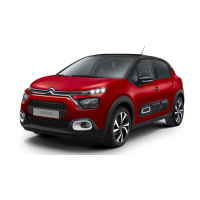80
Driving
After the engine has restarted, STOP
mode is not available until the vehicle
has reached a speed of 5 mph (8 km/h).
During parking manoeuvres, STOP mode
is not available for a few seconds after
coming out of reverse gear or turning the
steering wheel.
Engine restarting (START mode)
The engine automatically restarts as soon as the
driver indicates the intention of moving o again.
► With a manual gearbox: with the clutch
pedal fully depressed.
► With an automatic gearbox:
• With the selector in position D or M: with the
brake pedal released.
• With the selector in position N and the brake
pedal released: with the selector at D or M.
• With the selector in position P and the brake
pedal depressed: with the selector at R, N,
D or M.
• Reverse gear engaged.
Special cases
The engine will restart automatically if all
conditions for operation are met again and in the
following cases.
– Speed of the vehicle exceeds 2 mph (3 km/h).
– Some specic conditions (braking assistance,
air conditioning setting, etc.).
In these cases, this indicator lamp ashes
for a few seconds, then goes o.
Malfunctions
In the event of a malfunction, this warning
lamp ashes for a few moments, then
remains on, accompanied by an onscreen
message.
Have the vehicle checked by a CITROËN dealer
or a qualied workshop.
The vehicle stalls in STOP mode
All of the instrument panel warning lamps come
on if there is a fault.
► Switch o the ignition then start the engine
again with the key or the "START/STOP" button.
The Stop & Start system requires a 12 V
battery of specic technology and
specication.
All work concerning the battery must be
carried out only by a CITROËN dealer or a
qualied workshop.
Under-ination detection
This system automatically checks the pressures
of the tyres while driving.
It compares the information given by the wheel
speed sensors with reference values, which
must be reinitialised every time the tyre
pressures are adjusted or a wheel changed.
The system triggers an alert as soon as it
detects a drop in the ination pressure of one or
more tyres.
Under-ination detection does not
replace the need for vigilance on the part
of the driver.
This system does not avoid the need to
regularly check the tyre pressures (including
the spare wheel) as well as before a long
journey.
Driving with under-inated tyres, particularly
in adverse conditions (heavy load, high
speed, long journey):
– worsens road-holding.
– lengthens braking distances.
– causes premature wear of the tyres.
– increases fuel consumption.
The ination pressures dened for the
vehicle can be found on the tyre pressure
label.
For more information on the Identication
markings, refer to the corresponding section.
Checking tyre pressures
This check should be done when the
tyres are "cold" (vehicle stopped for 1 hour or
after a journey of less than 6 miles (10 km) at
moderate speeds).
Otherwise, add 0.3 bar to the pressures
shown on the label.
Snow chains
The system does not have to be
reinitialised after tting or removing snow
chains.
Under-ination alert
This is signalled by the xed illumination
of this warning lamp, accompanied by an
audible signal and, depending on equipment, the
display of a message.
► Reduce speed immediately, avoid excessive
steering movements and avoid sudden braking.
► Stop the vehicle as soon as it is safe to do
so.
The loss of pressure detected does not
always cause visible bulging of the tyre.
Do not rely on just a visual check.
► Using a compressor, such as the one in
the temporary puncture repair kit, check the
pressures of the four tyres when cold.
► If it is not possible to make this check
immediately, drive carefully at reduced speed.
► In the event of a puncture, use the
temporary puncture repair kit or the spare wheel
(depending on equipment).
The alert is kept active until the system is
reinitialised.

